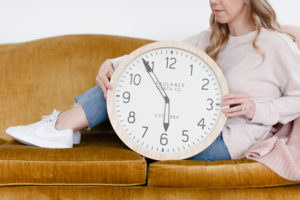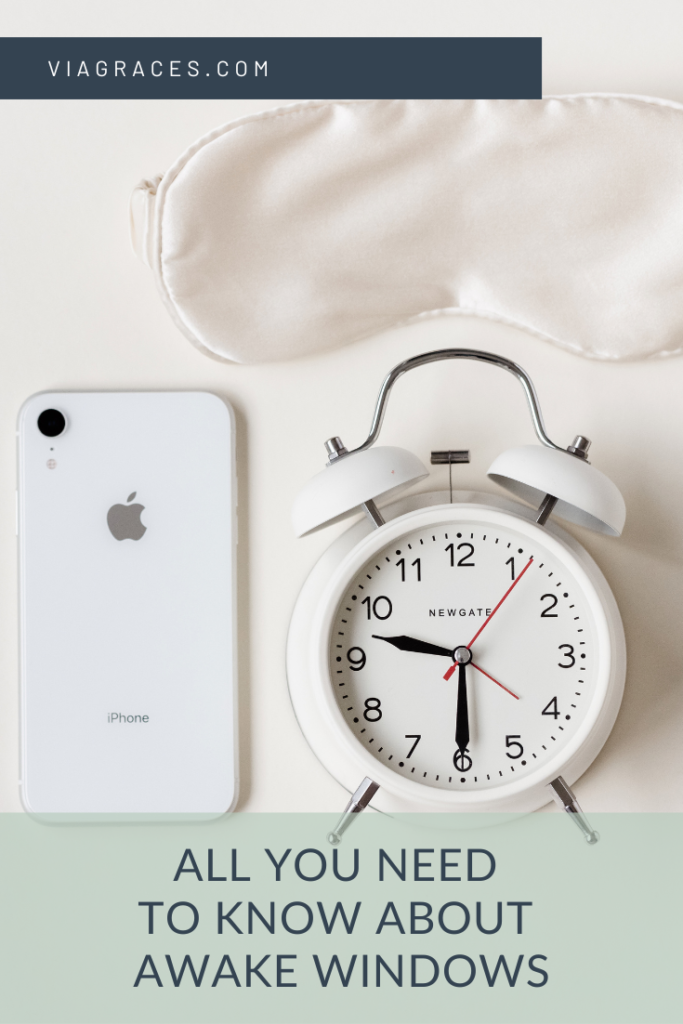If you have done much research in the newborn and baby sleep world, you’ve likely heard the term “awake windows,” or “wake windows.” It’s quite the buzzword when it comes to baby sleep, but there’s also a lot of confusion and misunderstanding around it.
Before I even jump in, I want to pause to say that yes, we of course use awake windows when we’re sleep training. But this is still really helpful and important for you to know even if you have no plans on sleep training in the near future! Undertiredness and overtiredness still impact a baby who co-sleeps or contact naps all day long, so this is for you, too.
In this blog post, I’m going to break down wake windows for you by discussing the following:
- What is an awake window?
- When to follow wake windows versus tired cues
- When awake windows start and when they end
- How to know when it’s time to change an awake window
- When to switch from awake windows to a clock-based schedule
And so much more! So let’s jump right in…
What is an awake window?
An awake window is essentially the amount of time your child is awake between sleeps. It’s in that window that your little one eats and plays.
When we refer to wake windows in the sleep world, we’re referring to the age-appropriate amount of time your little one can handle being awake, engaged, and interacted with before starting to dance with overtiredness; it’s that sweet spot of tired enough but not too tired.

Awake windows help parents determine when it’s time for the next nap, or when it’s bedtime. For the first several months of life, especially, naps and bedtimes are not simply based on the clock, but on awake windows; bedtime is not merely 7 pm because that’s what you heard is good for babies, bedtime should instead be based on when that final awake window ends.
Before I continue to chat through all things awake windows, you need to know about two free guides we offer. If you have a newborn 0-16 weeks old, our newborn routines freebie has all of the newborn awake windows inside. If you have a baby 4-17 months old, our baby schedule guide has all you need for your growing baby!
Now I’m going to answer some frequently asked questions about wake windows, as well as clear up some confusion around them.
When does an awake window start and when does an awake window end?
It does not take a lot for a newborn to get overtired (5 minutes can make quite the difference!), so a newborn’s awake window starts the moment their little eyes pop open.
For babies four months and older, however, the awake window starts when you actually get them out of their crib. So if your baby took a short nap and you wait 10 minutes before getting them, the wake window does not start when they woke up, rather it starts when you actually got them out of bed.
An awake window ends when you’re moving them toward sleep. This does NOT mean your baby should be asleep at the end of their awake window, but we want to give them a good chance of falling asleep at this point.
So if you are aiming for a crib nap, you should be laying your baby in their crib when that awake window ends. If you plan on going for a walk for your baby’s nap, they should be in your carrier or in the stroller by the time their awake window is over so they have the opportunity to fall asleep when they’re ready. Or if you’re simply going to snuggle your baby for their nap, rather than talking to them, playing with them, or really engaging them, put them up on your shoulder or cradle them in your arms, and give them a chance to doze off.
When to follow awake windows versus tired cues
When we had our oldest, I had never heard of awake windows – I only knew of tired cues. I knew that overtiredness could be really rough, so I watched for tired cues ridiculously closely.
The problem with just following tired cues, however, is that some babies show tired cues way too early, some show them way too late (hello, overtired!), and some babies simply don’t show any sleepy cues at all.
So when we work with families, we really focus on awake windows, and tired cues take the back burner. That’s not to say we completely ignore tired cues altogether, however, if a baby starts showing sleepy signals 45 minutes before their age-appropriate awake window ends, we’re going to try to push them a bit.
Because while they may be showing those tired cues, there’s a good chance they’re not tired enough. And when little ones aren’t tired enough, they could either struggle to fall asleep all the more, and/or have a really short nap due to a lack of sleep pressure. And we don’t want either of those to happen! So we start with their age-appropriate awake window and see how they do from there.
For more on tired cues, read this blog post.
Should awake windows be the same length all day?
A baby’s awake windows will likely vary from morning to evening. It’s often helpful to have a shorter wake window in the morning, to stretch it a bit in the afternoon, and then to have the longest awake window before bed – however, from morning to night, that awake window difference generally shouldn’t be more than 30-60 minutes.
For newborns, you may not actually change the awake windows from morning to night, or if you do, you may find that just a 5-minute difference works well. For example, your 6-week-old might do well with 50-55 minutes awake in the morning, 60 minutes awake during the day, and 65-70 minutes awake before bed.
Around 4 months old, however, those awake windows are likely going to be more like 15 minutes different. For example, your baby might do well with 1.5 hours awake in the morning, 1.75 hours awake during the day, and 2 hours awake before bed.
As your baby continues to get older, that difference will likely stretch more. For example, your 9-month-old will likely do well with 2.5 hours awake in the morning, 3 hours awake in the afternoon, and 3.5 hours awake before bed.
I have certainly worked with some babies who need more of the same awake windows across the board, and some have even need less awake time before bed, but the majority certainly follow this pattern of less time awake in the morning, and more right before bed.

How to determine when it’s time to change an awake window
The good news about awake windows is once you find your child’s sweet spot, it works really well! The challenging part of awake windows is that you have to keep changing them as your little one gets older, as they’re able to handle more and more time awake.
With newborns, I’ve found that awake windows usually change about every two weeks or so – just by 5 minutes at a time, but that’s a lot in newborn world. Again, around the four-month mark, you’ll find that your baby’s awake window sweet spot hangs on a bit longer, maybe more like 3-4 weeks, and then it’s time to shift again. And at this age, bumping those windows by about 15 minutes each time works well.
Once your baby is consistently on a two-nap schedule, those windows stop shifting so frequently, you can enjoy more of a clock-based schedule, and that schedule will remain pretty much the same for a few months.
But the way you’ll know it’s time to adjust those awake windows is that your baby will likely start fighting falling asleep more than they did before, or taking longer than usual to fall asleep (even if they’re content in doing so!). For independent sleepers, we aim for them to fall asleep within 5-10 minutes of being laid in their cribs. So when they start taking more than 10 minutes to fall asleep, they’re likely not tired enough and it’s time to shift that schedule!
Another sign it’s time to lengthen your baby’s awake window is they start taking shorter naps than before, waking more in the night, or starting the day extra early – they may not have enough sleep pressure to get the same long stretch of sleep they used to!
If either of these signs is happening over a few days and it’s been a couple of weeks since you’ve adjusted their schedule, it’s likely time to lengthen those wake windows.
Does adjusted age matter when it comes to determining wake windows?
Yes! Especially for younger babies. If your baby was born early, you will want to determine their awake window based on adjusted age. For newborns, this means your babe will essentially just be eating and sleeping – they likely won’t even be able to handle 45 minutes awake for the first few weeks of life!
Or if your baby is 6 months old but was born two months early (therefore four months adjusted), they will likely benefit from starting with awake windows closer to those of a four-month-old, maybe a five-month-old.
As your baby keeps getting older, however, especially once on a two-nap schedule, you will likely find that their adjusted age doesn’t impact sleep schedules as much anymore.
Do awake windows change based on short and long naps?
There is a big misconception that if your baby takes a 30-minute nap versus a 2-hour nap their awake window will change. But that’s just not the case most of the time! Simply because they napped longer does not mean they can last longer for the next awake window – they’ll still be ready for sleep at the end of their usual window.
Now I will say, if your baby takes a super short nap (less than 20 minutes or so), there’s a good chance they may need a slightly shorter wake window, but probably not by more than 15 minutes or so. And that’s where tired cues come in handy. If their nap was extra short, still aim for their standard awake window, but adjust according to what their tired cues are telling you.
When can I stop following awake windows so closely? When will my baby or toddler be on a predictable schedule?
Awake windows are great and all, but it’s also really nice to not have to do math all day long to figure out when your baby will sleep next. That’s why so many parents are anxious to move to more of a set, clock-based schedule.
When your baby transitions to a two-nap schedule (generally around 7 months or so) is when you can stop focusing so closely on awake windows and move to a by-the-clock schedule.
The schedule is very much based on awake windows. But at this point, we’re trying to focus more on the clock and help your baby’s body clock adjust to a more predictable clock-based schedule. You don’t have to switch to a set schedule if awake windows just work really well for you, but I will say I often find that moving to a set schedule can help fix some sleep challenges like short naps, inconsistent night wakings, and early mornings.
Check out this blog post to see how to go about making that transition.
And once your baby or toddler is on a one-nap schedule, I will say we really aren’t focused on awake windows anymore, but on a set schedule. Awake windows kind of help determine bedtime, especially as your toddler gets older and depending on how long their nap is, but toddlers’ sleep needs start to vary so widely at this age, we really just determine their schedule based on what they show us they actually need, and then adjust accordingly as they keep getting older.
Conclusion
Now that you know the ins and outs of awake windows, it’s time to put that knowledge to use!
The plan of this post is to teach you about all things awake windows! If you have a newborn or baby right now, it’s my hope that you walk away from this episode with a new schedule to try or an “ah ha” moment that just wasn’t clicking with awake windows before.
And remember to snag our free newborn and baby schedule guides! We use them with all of the families we work with, but also remember every baby is different. So you may find our six-month schedule is spot on for your six-month-old, or you may find that your six-month-old still benefits from the five-month schedule for two more weeks.
Or you may find that your six-month-old is actually ready for the transition to two naps a bit earlier than other babies! So don’t be discouraged if you have to play around a bit before you find the sweet spot for your baby.
I also want to add that for babies who aren’t sleep trained, these awake windows can get gray more easily. For some, especially as they get older and more distracted or start interacting or moving a lot more, it can take way longer to fall asleep when co-sleeping, or contact napping, as they want to interact with you! So it’s not necessarily that the awake windows are super off, but they just don’t want to sleep!
Whereas for those in a dark room lying in their cribs, there’s not a whole lot to do besides sleep. So if they’re tired enough and have the skills to fall asleep, they fall asleep!
If you’re looking for more help when it comes to figuring out your little one’s schedule, check out our online sleep classes or how we can support you one-on-one!
